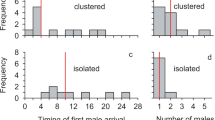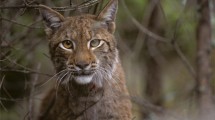Summary
Preference by females for choosing mates at male aggregations has been hypothesized as the primary selective pressure favoring the formation of leks, but alternative hypotheses account for lek formation without invoking female preference. Observational studies to determine whether male mating success increases with lek size, as predicted under the female preference hypothesis, have produced inconsistent results, possibly due to covariation of lek size with other variables or to male-male or intersexual conflict over lek size. We tested whether females prefer larger leks in a field experiment with ruffs (Philomachus pugnax), a lekking sandpiper, in which male group size, composition, and location were controlled. Wild females chose the larger of two adjacent groups often enough such that males in larger groups had significantly higher per capita rates of female visitation (Table 3). Such behavior would probably lead to higher per male mating rates at larger leks, which is generally considered a necessary condition for female choice to select for lek display (Fig. 2). Lek size in nature will reflect both female preference for larger leks and competition among males, which may favor smaller lek size. All else being equal, however, female ruffs preferred to visit larger groups strongly enough to maintain lekking by males.
Similar content being viewed by others
References
Alatalo R, Höglund J, Lundberg A, Sutherland WJ (in press) Evolution of black grouse leks: female preferences benefit males in larger leks. Behav Ecol
Alerstam T, Gudmundsson GA, Jönsson PE, Karlsson J, Lindstrom A (1990) Orientation, migration routes, and flight behaviour of knots, turnstones, and brant geese departing from Iceland in spring. Arctic 43:201–214
Alexander RD (1975) Natural selection and specialized chorusing behaviour in acoustical insects. In: Pimentel D (ed) Insects, science and society. Academic Press, New York, pp 35–77
Andersen FS (1948) Contributions to the biology of the ruff (Philomachus pugnax (L.)) II. Dansk Ornith Foren Tidsskr 42:125–148
Arak A (1983) Male-male competition and mate choice in anuran amphibians. In: Bateson P (ed) Mate choice. Cambridge University Press, Cambridge, pp 181–210
Beehler BM, Foster MS (1988) Hotshots, hotspots, and female preferences in the organization of lek mating systems. Am Nat 131:203–219
Bradbury JW (1981) The evolution of leks. In: Alexander RD, Tinkle DW (eds) Natural selection and social behavior. Chiron Press, New York, pp 138–169
Bradbury JW, Gibson RM (1983) Leks and mate choice. In: Bateson P (ed) Mate choice. Cambridge University Press, Cambridge, pp 109–138
Bradbury JW, Gibson RM, Tsai IM (1986) Hotspots and the dispersion of leks. Anim Behav 34:1694–1709
Bradbury JW, Gibson RM, McCarthy CE, Vehrencamp SL (1989) Dispersion of displaying male sage grouse. II. The role of female dispersion. Behav Ecol Sociobiol 24:15–24
Emlen ST, Oring LW (1977) Ecology, sexual selection and the evolution of mating systems. Science 197:215–223
Fretwell SD, Lucus HL (1970) On territorial behavior and other factors influencing habitat distribution in birds. Acta Biotheor 19:16–36
Gibson RM, Taylor CE, Jefferson DR (1990) Lek formation by female choice: a simulation study. Behav Ecol 1:36–42
Gosling LM, Petrie M (1990) Lekking in topi: a consequence of satellite behaviour by small males at hotspots. Anim Behav 40:272–287
Hamerstrom FN Jr, Hamerstrom F (1955) Population density and behavior in Wisconsin prairie chickens (Tympanuchus cupido pinnatus). Acta 11th Intern Ornithol Congr:459–466
Hogan-Warburg AL (1966) Social behavior of the ruff, Philomachus pugnax (L.). Ardea 54:109–229
Höglund J, Robertson JGM (1990) Spacing of leks in relation to female home ranges, habitat requirements and male attractiveness in great snipe (Gallinago media). Behav Ecol Sociobiol 26:173–180
Hurlbert SH (1984) Pseudoreplication and the design of ecological field experiments. Ecol Monogr 54:187–211
Koivisto I (1965) Behavior of the black grouse, Lyrurus tetrix (L.) during the spring display. Finn Game Res 26:1–60
Kruijt JP, Vos GJ de, Bossema I (1972) The arena system of the black grouse Lyrurus tetrix (L.). Proc Int Ornithol Congr 15:399–423
Lank DB (1983) Migratory behavior of semipalmated sandpipers at inland and coastal staging areas. Ph.D. thesis, Cornell University, Ithaca, New York
Lank DB, Smith CM (1987) Conditional lekking in ruff (Philomachus pugnax). Behav Ecol Sociobiol 20:137–145
Lill A (1976) Lek behavior in the golden-headed manakin, Pipra erytrocephala, in Trinidad (West Indies). Z Tierpsychol [Suppl] 18:1–83
Oring LW (1982) Avian mating systems. In: Farner DS, King JR, Parkes KC (eds) Avian biology, vol VI. Academic Press, New York, pp 1–92
Parker G (1978) Evolution of competitive mate searching. Anna Rev Entomol 23:173–196
Parker GA, Sutherland WJ (1986) Ideal free distributions when individuals differ in competitive ability: phenotype-limited ideal free models. Anim Behav 34:1222–1242
Phillips JB (1990) Lek behaviour in birds: do displaying males reduce nest predation? Anim Behav 39:555–565
Pruett-Jones SG (1985) The evolution of lek mating behavior in Lawes' parotia (Aves: Parotia lawesii). Ph.D thesis, University of California at Berkeley, Berkeley
Pulliam HR, Caraco T (1984) Living in groups: is there an optimal group size? In: Krebs JR, Davies NB (eds) Behavioral ecology, 2nd edn. Blackwell Press, Oxford, pp 122–147
Queller DC (1987) The evolution of leks through female choice. Anim Behav 35:1424–1432
Reynolds JR, Gross MR (1990) Costs and benefits of female choice: is there a lek paradox? Am Nat 136:234–243
Rhijn JG van (1973) Behavioural dimorphism in male ruffs, Philomachus pignax (L.). Behaviour 47:153–229
Rhijn JG van (1983) On the maintenance of alternative strategies in the ruff Philomachus pugnax. Ibis 125:482–498
Rhijn JG van (1991) The ruff. T & AD Poyser, London
Ryan MJ, Tuttle MD, Taft LK (1981) The costs and benefits of frog chorusing behavior. Behav Ecol Sociobiol 8:273–278
SAS (1985) SAS user's guide: statistics, version 5 edition. SAS Institute, Cary, NC
Scheufler H, Stiefel A (1985) Der Kampfläufer. Ziemsen Verlag, Wittenberg
Sokal RR, Rohlf FJ (1981) Biometry. Freeman, San Francisco
Sutherland WJ, Parker GA (1985) Distribution of unequal competitors. In: Sibly RM, Smith RH (eds) Behavioral ecology: ecological consequences of adaptive behaviour. Blackwell Press, Oxford, pp 255–274
Trail PW (1987) Predation and antipredator behavior at Guianan cock-of-the-rock leks. Auk 104:496–507
Vos GJ de (1983) Social behaviour of black grouse: an observational and experimental field study. Ardea 71:1–103
Waltz EC (1982) Alternative mating tactics and the law of diminishing returns: the satellite threshold model. Behav Ecol Sociobiol 10:75–83
Wegge P, Rolstad J (1986) Size and spacing of capercaillie leks in relation to social behaviour and habitat. Behav Ecol Sociobiol 19:401–408
Wiley RH (1974) Evolution of social organization and life history patterns among grouse (Aves: Tetraonidae). Q Rev Biol 49:209–227
Wrangham RD (1980) Female choice of least costly male; a possible factor in the evolution of leks. Z Tierpsychol 54:357–367
Author information
Authors and Affiliations
Rights and permissions
About this article
Cite this article
Lank, D.B., Smith, C.M. Females prefer larger leks: field experiments with ruffs (Philomachus pugnax). Behav Ecol Sociobiol 30, 323–329 (1992). https://doi.org/10.1007/BF00170598
Received:
Accepted:
Issue Date:
DOI: https://doi.org/10.1007/BF00170598




